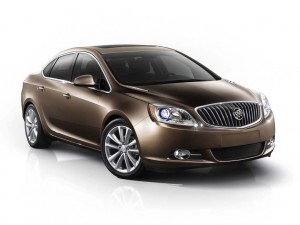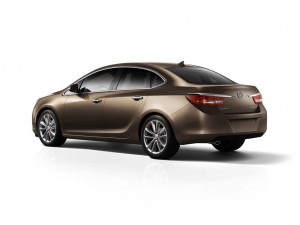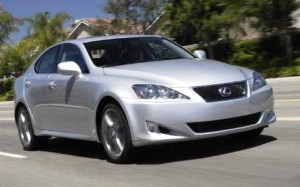When General Motors emerged from bankruptcy last year, after agreeing to eliminate half of its eight North American brands many observers were surprised to see Pontiac and Saturn, rather than Buick, on the list. The once popular brand had steadily declined, over the decades, and seemed to have little chance for a turnaround.
Or so went the conventional wisdom – which, as so often happens, has again proved wrong. The big Buick Enclave SUV was the first sign of life, with the LaCrosse sedan adding further spark to the nascent Buick revival. The recently launched Regal has received strongly positive reviews. But can Buick hit another one out of the park?
 It’s hoping so, and will reveal what’s next at the Detroit Auto Show’s media preview day, on Monday, Jan. 7, in the form of the all-new, 2012 Buick Verano, the brand’s first-ever entry into the compact luxury segment – and it’s third all-new sedan in three years.
It’s hoping so, and will reveal what’s next at the Detroit Auto Show’s media preview day, on Monday, Jan. 7, in the form of the all-new, 2012 Buick Verano, the brand’s first-ever entry into the compact luxury segment – and it’s third all-new sedan in three years.
“It’s really about product-driven momentum,” said Roger McCormack, the long-struggling brand’s product marketing director.
The addition of the Regal and, now, the Verano are particularly critical steps considering where the luxury market is moving. The growth is coming in the midsize and compact segments, not from flagships like the Mercedes-Benz S-Class, BMW 7-Series and Lexus LS460. Before Regal, Buick competed in just 14% of the luxury market, by volume. After Verano, the maker estimates, it will compete in 46%.
The new model will be particularly targeted against the likes of Audi’s A3 and the Lexus IS250, as well as the Volvo S40, according to Buick officials, rather than the two more established German offerings.
If the look of the new Verano is familiar, that’s no surprise. Buick is following a familiar strategy in the luxury market, one frequently seen with brands like BMW and Audi, taking a successful design and migrating it from model to model.
Luckily that doesn’t mean the Verano is just a downsized clone of the bigger LaCrosse; there are some nicely distinct touches, like the ambient blue halo rings around the projector headlamps which are, in turn, accented by chromed eyebrows that have the look of calligraphy, suggests chief designer Dave Lyon. The grille’s chrome is hand-blacked, and accented by satin metal finishes. And, of course, there are the signature Buick portholes, though with Verano they’re placed on top, rather than on the side, of the front fenders.
Dimensionally, Verano is 6 inches shorter than Regal, nose-to-tail, with a 2-inch shorter wheelbase. It’s also 2 inches narrower and 300 pounds lighter.
As the luxury market has evolved downward, makers have come to realize that smaller doesn’t necessarily mean less lavish. Even entry-luxury buyers now expect a fair share of opulence and plenty of high-tech electronics and safety equipment.
That means a variety of standard or optional features, from Bluetooth for hands-free calling to a large color navigation screen, OnStar and XM satellite radio. StabiliTrak and 10 airbags are standard, along with a collapsible pedal system designed to reduce injuries to the legs and feet in a frontal crash.
Heated seats, heated steering wheel and a USB connection for MP3 players are among the amenities that will be offered.
Buick claims it will be the quietest sedan on the market.
The Verano will be offered with a choice of 17 and 18-inch alloy wheels. It uses a McPherson front suspension and a Z-link rear.
Set for a late summer launch, the 2012 Buick Verano will come equipped with a 2.4-liter inline-four version of the GM Ecotec engine – shared with the bigger Regal – making 180 horsepower and 170 pound-feet of torque. It will be mated to a 6-speed automatic and is expected to launch from 0 to 60 in about 8 seconds, while delivering 23 mpg City and 30 Highway. Those numbers are solid, if not overwhelming.
A “later” addition will be a turbocharged 2.0-liter Ecotec that should appeal to performance enthusiasts with a 6-speed manual gearbox. In the Regal, that engine delivers 220 hp and gets 18 mpg City, 29 Highway. It should do a bit better in the smaller, lighter Verano.
And though engineering chief Jim Federico says that, “right now there aren’t any plans,” he hints that the eAssist hybrid system developed first for the LaCrosse is “prolific” enough that it just might migrate downward into models like Regal and Verano. The pressure could be on if, as a Shell oil executive recently suggested, fuel prices start nudging up toward $5 a gallon.
The Buick brand was a division the analysts long loved to hate. And buyers felt largely indifferent about. Ironically, it was the brand’s amazing success in China, where it has driven General Motors to become the booming market’s largest automaker (Click Here for that story) that convinced GM to hang onto Buick while ditching Saturn, Saab, Pontiac and Hummer in 2009.
Perhaps Buick’s problems open opportunities for success, a senior official suggested in an off-the-record aside. The marque had so few customers that now that it is launching a wave of new product Buick almost seems like a new brand to the latest generation of luxury buyers. But it has some tough and better-established competition, so Verano won’t have it easy when it comes to market later this year.




